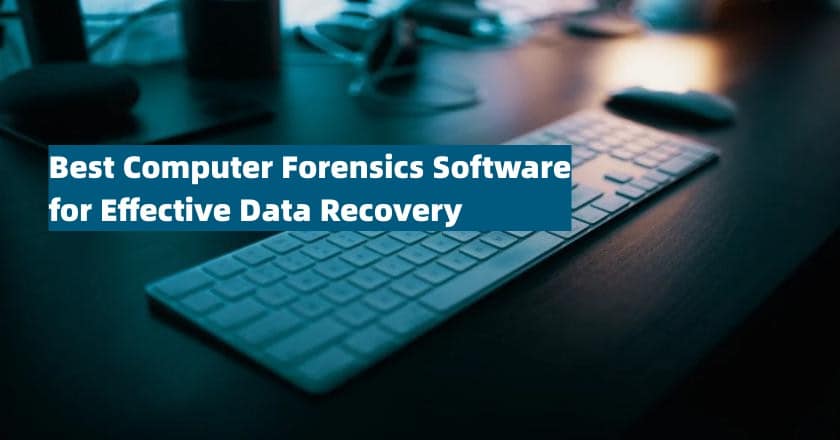
Best Computer Forensics Programs A Deep Dive
Best computer forensics programs are essential tools in today’s digital world, where unraveling cybercrimes and recovering crucial data requires specialized software. From identifying deleted files to reconstructing timelines of events, these programs are the digital detective’s best friend. This post explores the leading commercial and open-source options, highlighting their strengths, weaknesses, and the crucial role they play in investigations.
We’ll delve into the specifics of various forensic techniques, examining how different programs handle data recovery, memory analysis, and file carving. We’ll also discuss the hardware and software requirements, ethical considerations, and the ever-evolving landscape of computer forensics software, including the exciting potential of AI and cloud-based solutions. Get ready to become a more informed digital investigator!
Introduction to Computer Forensics Programs: Best Computer Forensics Programs

Computer forensics is a crucial field that bridges law enforcement, cybersecurity, and data recovery. It involves the scientific examination of digital devices and systems to identify, preserve, and present digital evidence in legal or investigative contexts. The importance of computer forensics is undeniable in our increasingly digital world, where crimes are increasingly committed and evidence is stored online.
From cyberattacks to fraud investigations, computer forensics provides the tools and techniques to uncover the truth hidden within digital data.Computer forensics programs are specialized software applications designed to assist investigators in their examination of digital evidence. These programs provide a range of functionalities that streamline the process of acquiring, analyzing, and reporting on digital data. They often incorporate features that ensure the integrity and admissibility of evidence in court.
Key Features and Functionalities of Computer Forensics Programs
Most computer forensics programs share a core set of functionalities. These include the ability to create forensic images of hard drives and other storage devices, ensuring that the original data remains untouched and preserving its integrity. They also typically provide tools for file carving, which recovers deleted or fragmented files, and data analysis, allowing investigators to search for specific s, file types, or patterns within the acquired data.
Furthermore, advanced programs often include features for network forensics, analyzing network traffic logs and identifying malicious activity. Many programs also offer timeline analysis, reconstructing the sequence of events based on timestamps associated with files and system activities. Finally, reporting capabilities are essential, allowing investigators to generate comprehensive reports detailing their findings for use in investigations and legal proceedings.
Examples of Digital Evidence Handled by Computer Forensics Programs
Computer forensics programs are used to analyze a wide variety of digital evidence. This includes emails and other electronic communications, which can reveal crucial details about criminal activities or disputes. Deleted files, recovered through file carving techniques, can provide vital evidence that might otherwise be lost. Web browser history and internet activity logs can track the online movements of suspects, while registry entries and system logs on a computer can reveal software installations, system configurations, and other crucial information.
Images and videos, often stored on digital devices, can provide visual evidence related to crimes. Finally, metadata associated with files, such as creation dates and modification times, can help establish timelines and corroborate other evidence. For instance, in a fraud case, examining financial transaction records stored on a suspect’s computer could provide definitive proof of illegal activity.
Similarly, in a cybercrime investigation, analysis of network logs could identify the source and method of an attack.
Top Commercial Computer Forensics Programs
Choosing the right commercial computer forensics software can significantly impact the efficiency and effectiveness of an investigation. The market offers a range of powerful tools, each with its own strengths and weaknesses. Selecting the appropriate software depends heavily on the specific needs of the investigator and the nature of the cases they handle. Factors such as budget, system requirements, and the types of data being examined all play a crucial role in this decision.
Commercial Computer Forensics Software Comparison
The following table compares five leading commercial computer forensics programs, highlighting their key features, pricing (which can vary based on licensing and features), and system requirements. Remember that pricing and system requirements are subject to change, so always check the vendor’s website for the most up-to-date information.
| Program Name | Key Features | Pricing | System Requirements |
|---|---|---|---|
| EnCase | Advanced data recovery, timeline analysis, email analysis, network forensics, report generation, write-blocking capabilities. Known for its robust features and widespread industry acceptance. | Contact vendor for pricing; typically a significant investment. | High-end specifications are recommended; powerful CPU, ample RAM (16GB+), significant storage space. |
| FTK (Forensic Toolkit) | Intuitive interface, comprehensive data analysis, hash calculations, searching, image processing, report generation. Popular for its user-friendliness and ease of use. | Contact vendor for pricing; generally less expensive than EnCase, with various licensing options. | Moderate system requirements; a solid CPU, 8GB+ RAM, substantial storage. |
| AccessData Forensic Suite | Combines multiple forensic tools (including FTK) into a single suite, offering a comprehensive solution. Allows for streamlined workflows. | Contact vendor for pricing; pricing will depend on the specific modules included in the suite. | Moderate to high system requirements, depending on the modules used. |
| X-Ways Forensics | Known for its speed and efficiency, especially with large datasets. Offers advanced features for data recovery and analysis. Supports a wide variety of file systems. | Contact vendor for pricing; licensing options vary. | Moderate to high system requirements; a fast CPU and significant RAM are beneficial. |
| Autopsy | Open-source digital forensics platform, offering many features comparable to commercial software. Benefits from a large community and constant development. | Free (open-source) | Moderate system requirements; performance will vary based on the size of the data being processed. |
Strengths and Weaknesses of Commercial Programs
Each program offers unique advantages and disadvantages. EnCase, for example, is renowned for its robustness and comprehensive features but comes with a high price tag and demanding system requirements. FTK excels in its user-friendly interface, making it accessible to investigators with varying levels of technical expertise, but might lack some of the advanced features found in EnCase. AccessData Forensic Suite offers a consolidated solution, streamlining workflows, but can be costly depending on the modules selected.
X-Ways Forensics prioritizes speed and efficiency, especially beneficial for large datasets, but its interface may be less intuitive than FTK. Autopsy, being open-source, provides a cost-effective alternative with a large community support, but may require more technical expertise to fully utilize.
Scenario Illustrating a Unique Feature
Imagine a case involving a sophisticated data wiping technique where the suspect attempted to completely erase their hard drive before law enforcement could seize the device. In this scenario, EnCase’s advanced data recovery capabilities, particularly its ability to recover data from fragmented or overwritten areas of a drive, would be crucial. Its powerful algorithms and specialized recovery techniques could potentially recover deleted files and reconstruct deleted folders, providing vital evidence that might be missed by less powerful tools.
The recovered data might contain incriminating information like deleted emails, documents, or browsing history, ultimately leading to a successful prosecution.
Open-Source and Free Computer Forensics Tools
The world of computer forensics isn’t solely dominated by expensive commercial software. A robust ecosystem of open-source and free tools offers powerful capabilities, particularly for individuals, smaller organizations, or those needing specific functionalities not found in commercial packages. While they might lack the polish and comprehensive features of their commercial counterparts, these free tools provide a valuable alternative for many investigations.
Understanding their strengths and limitations is crucial for effective digital forensics.
Several open-source tools have earned reputations for their effectiveness and community support. These tools often leverage community contributions, leading to continuous improvement and updates. However, it’s important to remember that the support and documentation may not be as extensive as with commercial products. This often translates into a steeper learning curve for users.
Three Prominent Open-Source Computer Forensics Tools
The open-source landscape offers a variety of tools, each with its own strengths. Three prominent examples are Autopsy, The Sleuth Kit, and FTK Imager. These tools represent different approaches to digital forensics, catering to various needs and skill levels.
Autopsy is a graphical user interface (GUI) built on top of The Sleuth Kit. It provides a user-friendly environment for analyzing disk images and other digital evidence. Its intuitive interface makes it accessible to investigators with varying levels of technical expertise. The Sleuth Kit, on the other hand, is a command-line toolset, offering more granular control and flexibility for experienced users.
Finally, FTK Imager, while not strictly open-source in its entirety, provides free functionality for creating forensic images of hard drives and other storage media, a critical first step in any digital investigation.
Comparison of Free and Commercial Tools
Comparing free and commercial tools reveals key differences in functionality, support, and overall capabilities. Commercial tools, such as EnCase and Forensic Toolkit (FTK), generally offer more comprehensive features, including advanced data recovery capabilities, integrated reporting tools, and extensive support from the vendor. They often boast a more polished user interface and better documentation. Free tools, while often powerful, might require more technical expertise to operate effectively and may lack the breadth of features found in commercial packages.
For instance, commercial tools might include sophisticated hashing algorithms or network analysis features not readily available in free tools.
| Feature | Commercial Tools (e.g., EnCase, FTK) | Free Tools (e.g., Autopsy, The Sleuth Kit) |
|---|---|---|
| User Interface | Typically more polished and user-friendly | Can be more technical and command-line based (e.g., The Sleuth Kit) or require a steeper learning curve (e.g., Autopsy, while GUI-based, still demands technical knowledge) |
| Feature Set | Broader range of functionalities, including advanced data recovery and reporting | More focused functionalities; often requires combining multiple tools for comprehensive analysis |
| Support | Dedicated vendor support and extensive documentation | Community support, often relying on forums and online resources; support may be less readily available |
| Cost | Significant upfront investment | Free to use |
Limitations of Relying Solely on Free Tools for Complex Investigations
While free tools are valuable assets, relying solely on them for complex investigations presents several limitations. The lack of centralized support can be a major hurdle when encountering unexpected issues or needing specialized guidance. Furthermore, the feature sets of individual free tools might not be sufficient for comprehensive analysis of complex cases involving encrypted data, extensive network traffic, or advanced malware.
Commercial tools often integrate multiple functionalities into a single package, streamlining the workflow and reducing the time needed for investigation. For example, a complex investigation involving multiple devices and encrypted data might require the use of several open-source tools, each with its own learning curve, compared to the more integrated approach offered by commercial software. The time saved by using a commercial suite with integrated functionality can be significant in a time-sensitive investigation.
Specific Forensic Techniques and Their Associated Programs
Delving into the world of computer forensics requires a deep understanding of various techniques and the specialized software used to execute them. This section explores some common forensic techniques, the tools often employed, and how their methodologies can differ. Understanding these nuances is crucial for effective digital investigations.
Data Recovery
Data recovery aims to retrieve information from damaged, formatted, or deleted storage media. This often involves recovering files that the operating system no longer recognizes. The process involves identifying file signatures, reconstructing file structures, and recovering data from unallocated space.
Several programs excel at data recovery. Recuva, a popular freeware option, employs a simple interface and effective scanning algorithms to locate deleted files. On the other hand, more advanced tools like PhotoRec, a command-line utility, can handle more complex scenarios involving severely damaged media. PhotoRec’s strength lies in its ability to recover file fragments based on their header and footer signatures, even without knowing the file system.
While Recuva relies heavily on file system metadata, PhotoRec’s file carving approach makes it incredibly useful when file system information is corrupted or missing. This difference in approach highlights the versatility needed in a digital forensic toolkit.
File Carving
File carving is the process of extracting files from a data source without relying on the file system’s metadata. This is invaluable when the file system is damaged or when dealing with unallocated space. The process hinges on identifying characteristic file signatures (unique byte sequences at the beginning and/or end of files). Tools then reconstruct the files by locating these signatures and piecing together the data between them.
Both PhotoRec (mentioned above) and Scalpel are powerful file carving tools. Scalpel offers a command-line interface and provides more granular control over the carving process, allowing for specification of file types and carving ranges. It leverages a database of file signatures to identify and extract files. The difference between PhotoRec and Scalpel lies in their flexibility; PhotoRec excels in its simplicity and speed for general recovery, while Scalpel provides more precise control for specialized situations requiring focused extraction.
Memory Analysis
Memory analysis involves examining the contents of computer memory (RAM) to identify running processes, malware, and other artifacts of malicious activity or system compromise. This is a time-sensitive process, as volatile memory is lost when the system is powered off. Techniques involve analyzing process memory, identifying network connections, and recovering deleted data that might reside in RAM.
The Volatility Framework is a widely used open-source tool for memory analysis. It offers a wide range of plugins for various tasks, such as analyzing processes, network connections, and identifying malware. FTK Imager, a commercial tool, also provides memory analysis capabilities, but often integrates it within a broader digital forensics workflow. Volatility’s command-line interface requires a steeper learning curve, but it offers exceptional flexibility and customization.
FTK Imager, conversely, provides a more user-friendly interface, making it accessible to investigators with less technical expertise, although potentially sacrificing some level of fine-grained control. This trade-off between user-friendliness and advanced features is a common theme in digital forensics tools.
Hardware and Software Requirements
Building a robust and efficient computer forensics workstation requires careful consideration of both hardware and software specifications. Insufficient resources can significantly impact the speed and reliability of forensic analysis, potentially leading to incomplete investigations or inaccurate conclusions. A well-equipped workstation ensures investigators can handle large datasets, run demanding forensic tools, and maintain a secure environment crucial for preserving evidence integrity.The performance of leading computer forensics programs is heavily dependent on the underlying hardware and software.
Factors such as processing power, RAM, storage capacity, and the operating system all play a critical role in determining the speed and efficiency of forensic analysis. For example, analyzing a large hard drive image requires significant processing power and ample RAM to prevent system slowdowns or crashes. Similarly, insufficient storage can limit the number of cases that can be actively worked on simultaneously.
Minimum Hardware Specifications
The minimum hardware requirements vary depending on the specific forensic software used and the complexity of the cases being investigated. However, a general guideline for a capable workstation includes a minimum of a 64-bit Intel Core i7 processor or AMD equivalent, 16 GB of RAM (32 GB or more is highly recommended), and a solid-state drive (SSD) with at least 1 TB of storage.
More demanding tasks, such as analyzing encrypted drives or large datasets, will benefit significantly from higher specifications. For example, a case involving a terabyte-sized hard drive image would be significantly slower on a system with only 8GB of RAM, potentially leading to delays and frustration. A dedicated graphics card is not strictly necessary for most forensic tasks, but it can improve the performance of certain visualization tools.
Minimum Software Specifications
The operating system is a fundamental component of the forensic workstation. Many forensic tools are designed to run on Windows, but Linux distributions like Kali Linux are also popular choices due to their security features and open-source nature. Regardless of the operating system chosen, it’s essential to keep the system updated with the latest security patches to mitigate vulnerabilities.
The software requirements will depend on the specific tools used, but a general requirement includes a robust and reliable operating system, a forensic imaging tool (e.g., FTK Imager, EnCase), and a disk analysis tool (e.g., Autopsy, The Sleuth Kit). The choice of specific tools will depend on the investigators’ needs and preferences, but compatibility and regular updates are crucial.
Impact of Insufficient Resources
Insufficient resources can lead to several problems during forensic analysis. Slow processing speeds can significantly increase investigation time, delaying the delivery of results. Limited RAM can cause software crashes or data corruption, potentially compromising the integrity of evidence. Insufficient storage space can prevent the acquisition of large data sets or limit the number of cases that can be handled concurrently.
These issues not only hinder the efficiency of the investigation but can also impact the reliability and accuracy of the findings. For instance, a system running low on RAM while processing a large memory dump could lead to incomplete analysis or inaccurate conclusions.
Best Practices for Maintaining a Secure and Efficient Forensic Workstation
Maintaining a secure and efficient forensic workstation is paramount. Regular software updates, including the operating system and forensic tools, are crucial for patching security vulnerabilities and ensuring optimal performance. Employing strong passwords and multi-factor authentication adds an extra layer of security. Regular backups of the workstation’s data are essential to protect against data loss due to hardware failure or malicious attacks.
Additionally, implementing a robust antivirus solution and regularly scanning for malware can help prevent infections that could compromise the integrity of evidence. Finally, maintaining a clean and organized workstation can improve efficiency and reduce the risk of errors during analysis. Regularly cleaning up temporary files and unnecessary programs helps to free up disk space and improve system performance.
Ethical Considerations and Legal Ramifications
Computer forensics, while a powerful tool for uncovering the truth, operates within a complex landscape of ethical considerations and legal ramifications. The potential for misuse, misinterpretation, and violation of privacy necessitates a deep understanding of the legal and moral boundaries governing the field. Ignoring these aspects can lead to serious consequences, including legal repercussions and damage to professional reputation.The ethical use of computer forensics programs hinges on respecting individual privacy rights and maintaining a strict chain of custody for all digital evidence.
Data privacy is paramount; investigators must adhere to relevant laws and regulations, obtaining proper warrants and consent before accessing any data. Furthermore, maintaining the integrity of the evidence is crucial; any unauthorized access or alteration can compromise the admissibility of the evidence in court.
Data Privacy and Chain of Custody
Data privacy is a cornerstone of ethical computer forensics. Investigators must strictly adhere to legal frameworks such as the Fourth Amendment in the United States (protecting against unreasonable searches and seizures) and the GDPR in Europe (regarding the processing of personal data). This involves obtaining legally valid warrants before accessing data on a suspect’s computer or other digital devices.
Furthermore, all actions taken during the investigation must be meticulously documented to maintain an unbroken chain of custody, proving the evidence’s integrity and authenticity. Any deviation from established procedures can render the evidence inadmissible in court. For example, if an investigator accesses data without a warrant, the evidence obtained might be deemed inadmissible, even if it is relevant to the case.
Legal Ramifications of Improper Use
Improper use or misinterpretation of forensic evidence can have severe legal consequences. Presenting fabricated or manipulated evidence can lead to wrongful convictions, while the omission of exculpatory evidence can result in the failure to bring guilty parties to justice. These actions can result in criminal charges against the investigator, civil lawsuits against the organization employing the investigator, and professional sanctions from governing bodies.
The repercussions extend beyond the legal sphere; a tarnished reputation can severely impact an investigator’s career. For example, the case ofState v. Jones* (a hypothetical case for illustrative purposes) illustrates how the failure to properly maintain chain of custody led to the dismissal of crucial evidence and jeopardized the prosecution’s case.
Real-World Case Examples
Several high-profile cases highlight the importance of ethical conduct and adherence to legal procedures in computer forensics. While specific details are often kept confidential due to ongoing investigations or legal proceedings, we can draw lessons from publicly available information about cases involving data breaches or cybercrime. In many instances, disputes arise regarding the legality of data acquisition or the interpretation of digital evidence, leading to legal challenges and appeals.
The outcome of these cases often depends on the thoroughness of the investigation and the adherence to strict ethical and legal guidelines. For instance, the controversy surrounding the use of certain forensic techniques in high-profile cases often leads to extensive legal debate over the admissibility and interpretation of digital evidence, emphasizing the need for rigorous standards and ethical considerations.
Future Trends in Computer Forensics Software

The field of computer forensics is constantly evolving, driven by the rapid advancements in technology. New methods of data storage, communication, and encryption necessitate the development of equally sophisticated software to effectively investigate digital crimes. This evolution is shaping the future of digital investigations, impacting how forensic professionals select and utilize their tools.The integration of artificial intelligence (AI) and the increasing reliance on cloud-based solutions are two prominent trends significantly altering the computer forensics landscape.
These advancements offer unprecedented opportunities for enhancing efficiency and effectiveness but also introduce new challenges and complexities.
AI Integration in Computer Forensics
AI is poised to revolutionize various aspects of computer forensics. Machine learning algorithms can automate time-consuming tasks such as data triage, identifying relevant files amidst massive datasets, and correlating information across multiple sources. For instance, AI can significantly speed up the process of analyzing large hard drives by prioritizing the most likely areas containing crucial evidence. This automated analysis not only saves investigators valuable time but also reduces the risk of human error.
Furthermore, AI-powered tools can analyze complex network traffic patterns to identify suspicious activities, predict potential cyber threats, and uncover hidden connections between seemingly unrelated events—capabilities that far exceed the capacity of manual analysis. The application of AI in image and video analysis can also improve the identification and extraction of crucial evidence from multimedia files.
Cloud-Based Computer Forensics Solutions
The increasing reliance on cloud services for data storage and processing is transforming how digital investigations are conducted. Cloud-based forensic platforms offer several advantages, including scalability, accessibility, and collaboration capabilities. Investigators can access and analyze data remotely, regardless of their physical location, fostering better teamwork and reducing logistical challenges. Cloud solutions also provide access to powerful computing resources that may be unavailable to individual investigators or smaller agencies.
However, the use of cloud-based tools also presents unique challenges, such as ensuring data security and privacy, navigating jurisdictional issues related to data storage, and adapting to the ever-changing cloud computing landscape. A real-world example is the increasing use of cloud-based forensic platforms by law enforcement agencies to analyze seized mobile devices remotely, allowing for faster processing and collaboration among investigators.
Impact on Selection and Use of Computer Forensics Programs, Best computer forensics programs
The emergence of AI and cloud-based solutions will inevitably influence the selection and utilization of computer forensics programs. Investigators will need to evaluate software based on its ability to integrate with AI tools and support cloud-based workflows. This means that training and expertise will need to adapt to incorporate the skills required to effectively use these new technologies.
The need for specialized training in AI algorithms and cloud security will become paramount for computer forensic professionals. Furthermore, the selection process will also need to consider the security and privacy implications of using cloud-based platforms, and agencies will need to establish robust protocols to ensure compliance with data protection regulations.
Conclusion
Choosing the right computer forensics program depends heavily on your specific needs, budget, and the complexity of the investigations you undertake. Whether you opt for a powerful commercial suite or a combination of open-source tools, understanding their capabilities and limitations is key. Remember, ethical considerations and legal ramifications are paramount throughout the entire process. The field of digital forensics is constantly evolving, so staying updated on the latest software and techniques is crucial for success in this critical area.
Answers to Common Questions
What is the difference between commercial and open-source forensics software?
Commercial programs often offer more comprehensive features, better support, and regular updates, but come with a price tag. Open-source tools are free but may lack some advanced features and have less robust support.
Do I need specialized hardware for computer forensics?
While not strictly required for all tasks, a dedicated forensic workstation with sufficient RAM, storage, and processing power significantly improves performance and reliability, especially when dealing with large datasets.
How can I ensure the chain of custody is maintained?
Meticulous documentation is key. Record every step of the process, including date, time, actions taken, and any changes made to the evidence. Use secure hashing to verify data integrity.
What are some common ethical dilemmas in computer forensics?
Balancing the need to gather evidence with respecting an individual’s privacy rights is a major ethical challenge. Improper access to data or misinterpreting findings can have serious legal consequences.





